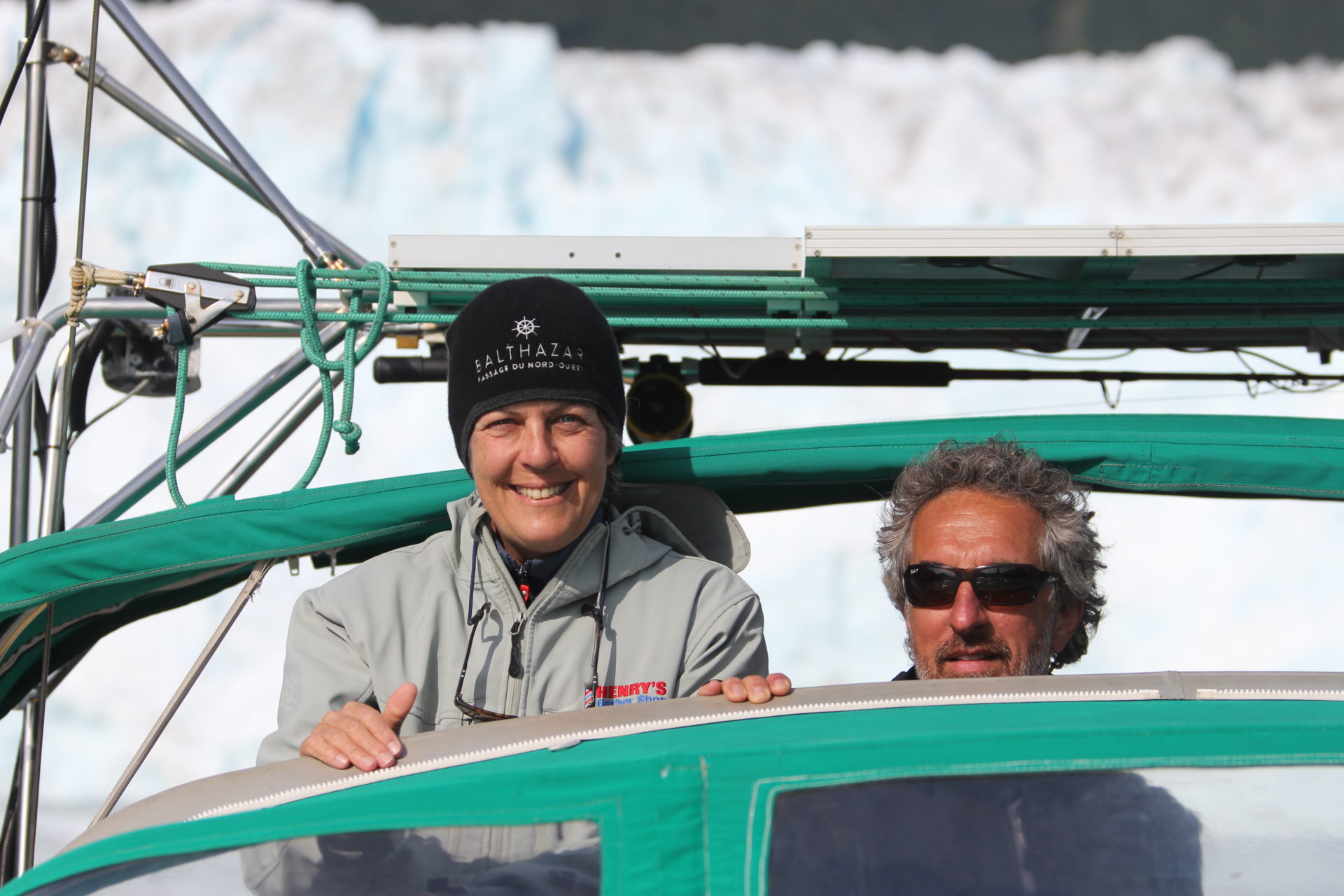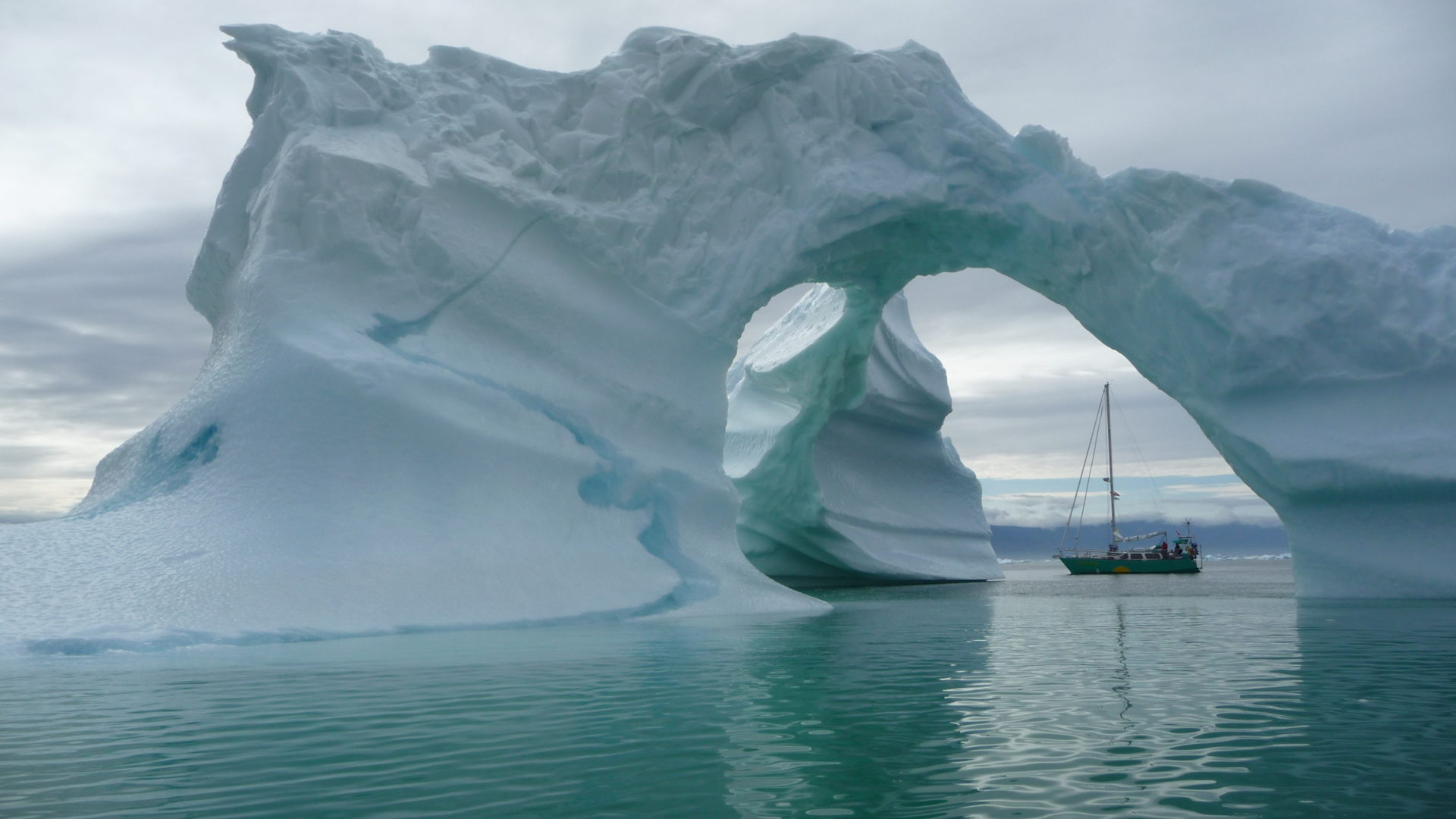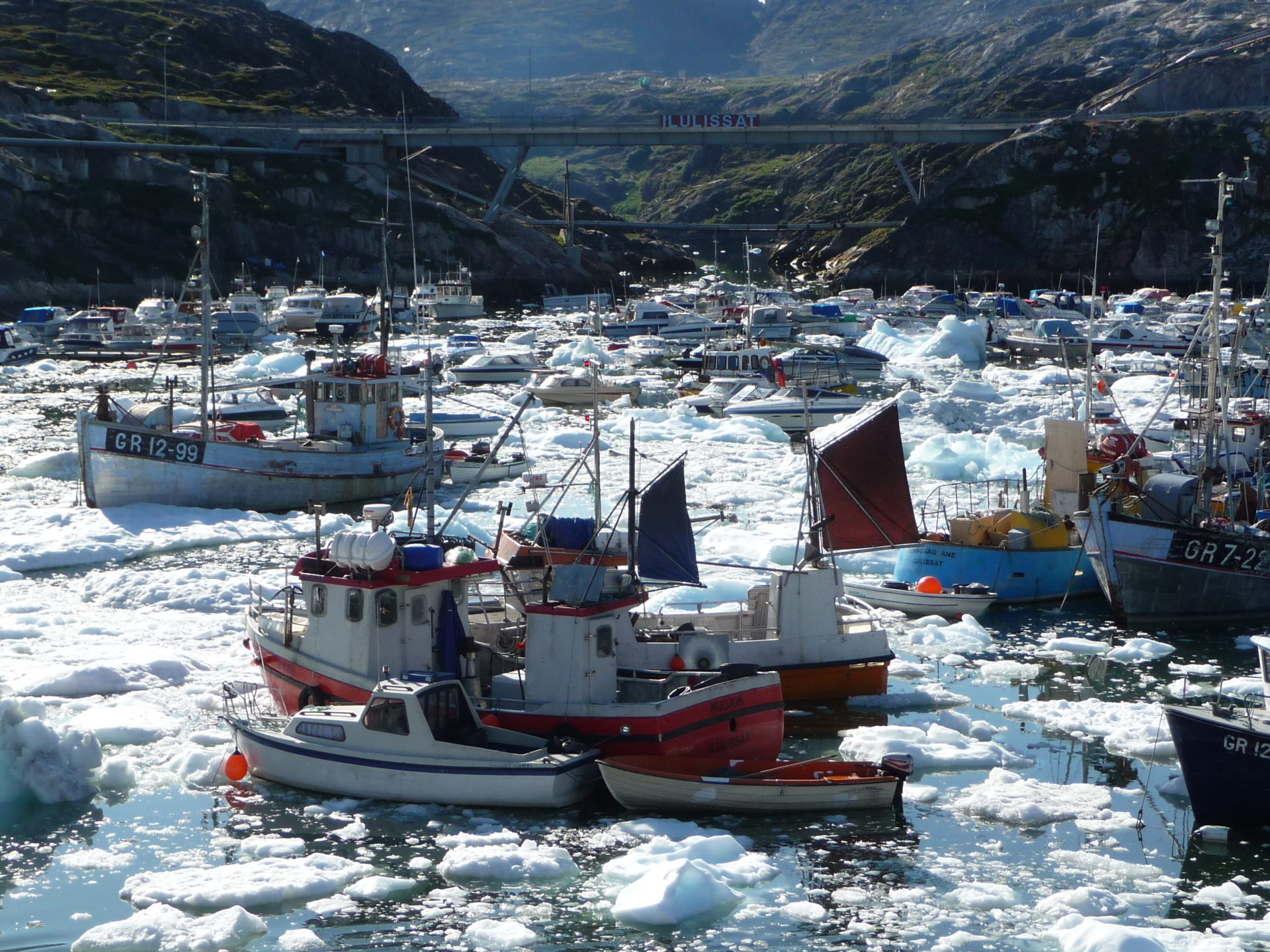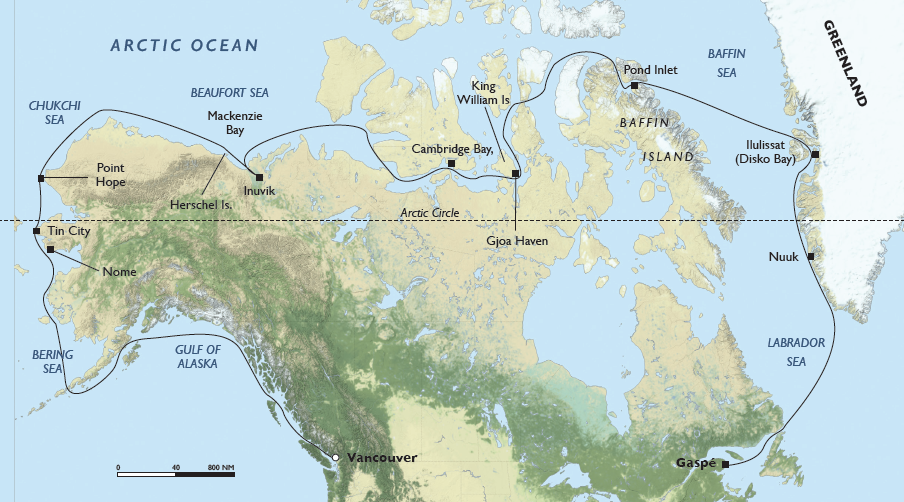It was in the launderette at Westview Marina that we began chatting to an unassuming Quebecois couple who apologized for loading the washer a few minutes before we arrived. Chat naturally lead to where had they been sailing. “Up North” came the reply, then: “We have completed a sail of the Northwest Passage.” The whir of the washer filled the silence as we took in these astounding words.
There are coastal cruising sailors, courageous ocean-going sailors, and then there are the very few adventurer sailors who are daunted by nothing.
Guy Lavoie and Claire Roberge are a remarkable couple. In 1987 they embarked on a plan to build Balthazar, a Gilbert Caroff designed 35-foot sloop-rigged, steel-hulled sailboat. Like many, their dream was to sail the world. Over a seven-year period every spare penny they had went into the building of Balthazar while Guy ran his printing business and Claire pursued her work in physical education and raised their two daughters.

In 1999 they sold the printing business, their house and possessions, lifted their two young daughters onto Balthazar and, leaving behind the cares of a conventional life, headed down the Intracoastal Waterway learning to sail as they went. Over a five-year period their voyage took them through the Panama Canal to Australia, Indonesia, Africa, and the West Indies until they returned to re-enter a routine and settled lifestyle in the Eastern Townships of Quebec, South of Montreal in 2004.
But the settled lifestyle did not hold forever. The unfettered freedom of the ocean was calling again. Guy was in need of another challenge to satisfy his pressing urge for adventure and Claire, knowing its importance to him, agreed they would take on a daring voyage that few had done before them. They would sail their 35-foot Balthazar from Gaspe to Greenland, through the Canadian Arctic Islands, over the top at Point Barrow Alaska, through the Aleutian island chain, down the south coast of Alaska and into the cruising waters of British Columbia.
Unlike their world circumnavigation, there were no dreams of warm sandy Caribbean anchorages or the pleasant breezes of idyllic islands of the South Pacific to draw them on. No, this trip was adventure at its most raw and demanding. It would require enormous courage and be a test of everyone on board.
Balthazar slipped her moorage in mid June 2012 with a crew of four and sailed out of the Gulf of Saint Lawrence into the Labrador Sea.
As Balthazar left the relative safety of the Gaspe Peninsular, Guy, who had sailed most of the world’s oceans, felt the butterflies rise in his chest. It was a mixture of anxiety and elation as he left the security of the known for the excitement, uncertainty, danger and discovery of the unknown that lay ahead of him.
The first few days of sailing were difficult. The weather freshened to 35 knots and the sea rose to four metres, sail was reduced to the minimum, everyone was wet from the lashing spray, they were cold and tired. There was seasickness. And at night the first iceberg was spotted on radar. Visibility in the fog was down to 100 metres. For a number of days the difficult conditions continued. They veered away from numerous icebergs. Then the barometer rose and the sailing got easier. After 700 miles and eight days the grey coast of Greenland came into view. There was relief on arrival in Nuuk, the capital of Greenland (population 17,000). For most of July they enjoyed the many colourful small ports and hospitable people of Greenland as they worked their way up the west coast to Illulissat (Disko Bay) and Sarqaq.


Their passage up the coast was not easy and involved numerous aborted attempts into a fierce wind and persistent rain, only to return to the safety of the inland fjords to try again another day. Delays forced them to waive their rules for coastal sailing: no more than 30 miles per day and no more than two days in a row. The result: tiredness set in.
Navigating to Illulissat was their first real test in the ice floes that ranged from table-sized growlers to massive icebergs calved from the nearby glacier. At least the visibility was good. The ice was on the move and they took brief, demanding, turns at the helm for 11 hours until they arrived at a port that appeared barred by an ice dam. They threaded their way through and tied to some fish boats. In the morning they awoke to a harbour locked in ice.
The weather in Greenland was mostly wet, except in Disko Bay where the sun shone brightly and they soaked up its warmth. Their daily lot for the 20-day voyage through the Canadian Arctic Archipelago was to be fog, rain, snow and cold. Even though they “ate like ogres” dining well on hearty roasts, stews, and heavy deserts, they lost weight.
From Illulisat, Greenland, to Pond Inlet in the Canadian Arctic is a four-day crossing of the Davis Strait in a northwesterly direction. The passage went well as they slalomed between the drifting icebergs. Claire was introspective at the helm. Could she go on with this?
Sailing in these latitudes means the autopilot is useless, as its compass is thrown off by the influence of the Pole. When motoring, which Balthazar did 50 percent of the time, someone is required at the helm constantly. When under sail in clear water the mechanical wind vane self-steering allows the crew more time to relax.
The passage from Pond Inlet to Gjoa Haven past Baffin Island and through the mile-wide Bellot Strait took them 12 days, not the predicted five. They departed August 12 confident of a good weather forecast but four hours later a sudden gale on the nose forced them back for two days. On the second departure it was two degrees and a storm force wind from behind sent them way too fast, fully reefed, between icebergs and ice floes at night. Even though there was no darkness at that latitude, visibility was low with the sea foam, hail and snow swirling about. But they pushed on under the pressure of time, as now every day of delay would bring them closer to winter. When they arrived at Gjoa Haven they were almost out of fuel and food—a serious condition in these waters where temperatures are at freezing point at night and typically eight degrees in the day.
Their weather fax radio had failed leaving Greenland and there was no spare. From Pond Inlet they had a satellite phone and by calling friends in Quebec they could get a weather forecast read out to them. Internet was only available in the few settlements and was usually poor. They also carried a Spot personal locator beacon so friends and family could follow their progress when other communications were unavailable.
The Canadian Ice Service provides daily updated status information on ice conditions and 30-day forecasts in areas of known marine activity. They distinguish more than 100 types of ice and conditions—a science in itself.
The Strait of Bellot was clear and they transited without incident. Further south they met a gale that blew the ice pack toward them. They were forced back into an uncertain anchorage. Two days later the wind ceased and the engine was on again. Such is the uncertainty of sailing in the arctic islands.
And, yes, surprisingly, they did meet a few other sailboats en route but compared to Greenland there was almost no living soul seen in the Canadian archipelago outside of the few small population centres. The crew described a desolate landscape where no plant grows higher than 10 centimetres, no animals were seen on land, and a stormy sky rarely showed a patch of blue. Yet the waters teemed with whales and seals and the skies with numerous birds.
That vision of desolation was erased at the human settlements they visited where they were greeted warmly and with an overwhelming generosity that only people living in isolation will give. They are helped immeasurably, meet families, they are entertained, given access to showers and laundries and are assisted in picking up supplies of fuel and food.
Their 240-mile route from Gjoa Haven to Cambridge Bay took them near to where Franklin’s Terror was found in September 2016 off the southwest coast of King William Island. All hands were lost to exposure and starvation in an ill-fated attempt to find the very passage Guy and Claire were now sailing. Indeed, throughout their voyage the crew of Balthazar could not escape the dreadful history of those who had suffered immeasurably or lost their lives in the exploration of these waters.
Their next challenge was the 75-mile trip up the Mackenzie River to Inuvik, and it proved hazardous. Guy had a foreboding because they could not find the paper chart that he always had at hand as back-up to the chart plotter; a sailor’s superstition perhaps. They had to rely on markers, many of which had been taken out by the winter’s ice. And then came the inevitable grounding on a sandbar that took hours to relieve with anchors, kedging, and the halyard being hauled by the eight-horsepower dinghy. When off, they proceeded slowly with crew in the dinghy cautiously taking soundings ahead of them.
The relief on reaching Inuvik was palpable among the crew. In Inuvik, Balthazar, having completed 4,000 miles in three months, was hauled out and prepared for winter and they all flew home.
Back in Quebec, it took a month before the stress of the voyage lifted and Guy and Claire could reflect somewhat dispassionately on their experience. True they had had the intimate bond between husband and wife and the support of their crew, but they had faced extreme isolation in a hostile environment far from their known world. At times, the severe weather, the confinement of a small boat, the moving ice, and the technical difficulties had seemed unsolvable. And every delay by ice or weather meant the onset of winter was closer and the possible abandonment of the voyage. The magnitude and accomplishment of the voyage slowly dawned on them.
Balthazar was launched again in Inuvik on June 29 the following year when the weather was 32 degrees in the shade and the boat shrouded in mosquitoes. Departure had to await the breakup of the ice on the coast. They made a sail plan with 18 possible moorings and distances of typically 30 to 165 miles between them. They anchored for three days in the Mackenzie Delta 50 miles from Inuvik waiting for the 35-knot winds to subside and the ice to move out of Mackenzie Bay. When it was time to leave they faced a maze of shallows in the delta where the boat became grounded three times in soft mud. The electronic charts were unreliable and their waypoints were off. Anchoring the boat, they spent hours in the dinghy surveying the bottom to find a way through with at least the three feet of depth required by their pivoting keel.
To Herschel Island and beyond the sailing was good, the weather warm and there was no ice, partly due to the warmer water of the Mackenzie River that flows from the south. But as they entered northern Alaska waters they met the growlers again and huge plates of ice blown in from the Beaufort Sea. These blocked access to their intended anchorage, forcing them on a further 30 miles. And once again they met dense fog that only revealed the many growlers at the last moment when collision could be avoided. This was intense sailing. They took one hour each at the helm, and arrived after midnight. A midnight sun maybe, but the cloud had kept it hidden for 10 days.
The north coast of Alaska coast offers numerous anchorage possibilities in lagoons formed by gravel beds and sand spits but entry is usually shallow and risky and the sand and gravel shift over time, rendering the charts useless. In addition, the position of longitude and latitude is shifted, often by as much as 100 meters. For Guy and Claire, visibility was often severely reduced by fog and rain. Inevitably, fatigue descended but morale on board remained good even though the navigation was taking its toll. Guy wrote he was dreaming of trade winds, swaying palms and long passages in the tropics!
The shallow waters and currents of the Chukchi Sea and the Bering Strait do not need strong winds or many hours to lift seas to aggressive heights. Balthazar did encounter heavy seas in the area off Point Hope and Guy says they passed through the Bering Strait in “furious katabatic winds” but they appeared to take this all in stride. After 40 hours of tough sailing they were able to anchor safely in front of the abandoned village of Tin City. The sun finally came out, it was 30 degrees, and they felt they were in paradise. North Alaska is flat and barren, to the south the barrier formed by the Aleutian Islands is volcanic, the mountains rise to 2,500 meters; they were thrilled by the majestic peaks now before them.
But it was mid August and the short summer was coming to an end. After 1,000 miles Guy and Claire decided it would be best to overwinter Balthazar in Nome, Alaska. It was the completion of their Northwest Passage. The following July they would return to sail through the Aleutian Islands and down the Alaskan coast into the waters of British Columbia. By comparison, that would be a piece of cake.
Claire and Guy continue to sail and write about the BC Coast while writing their blog and preparing for future presentations to be made in Quebec. For more info go to voilierbalthazar.ca.

